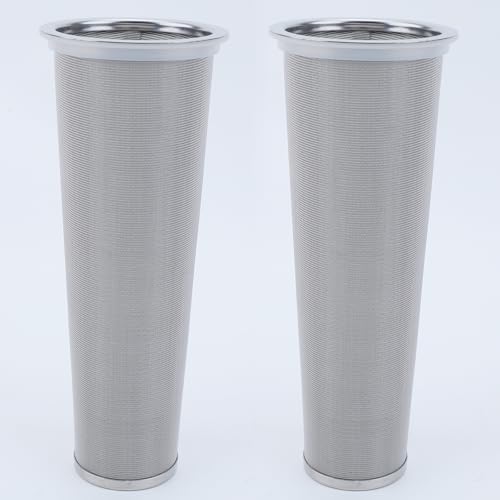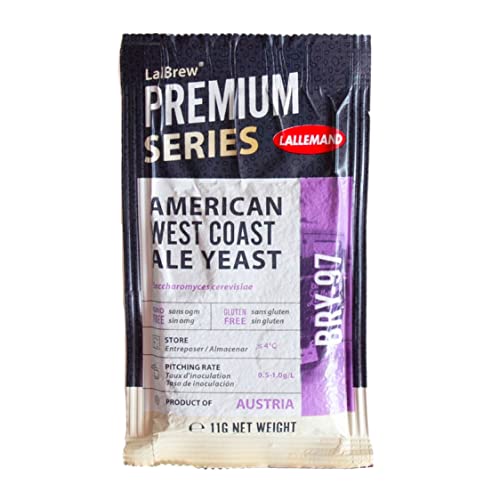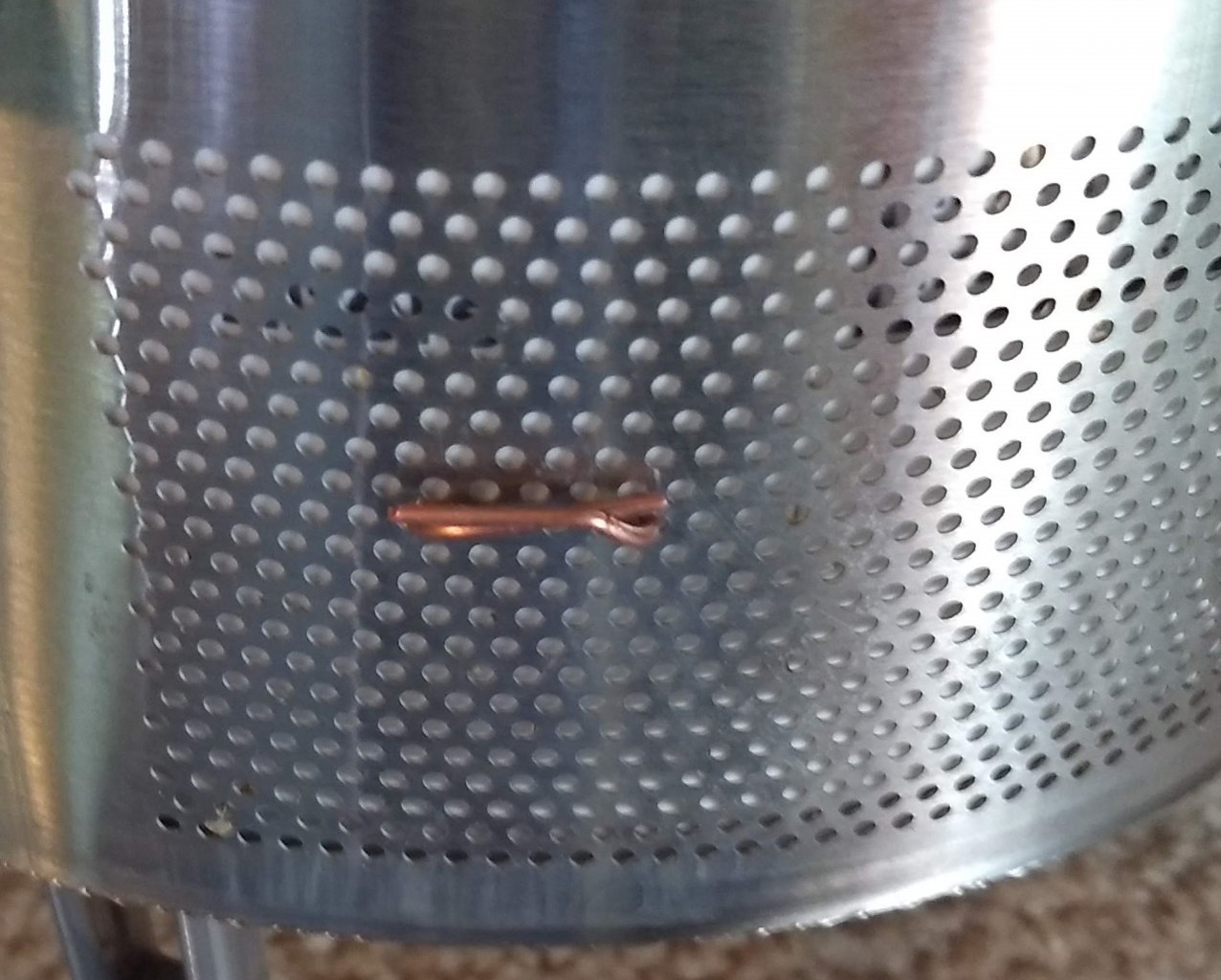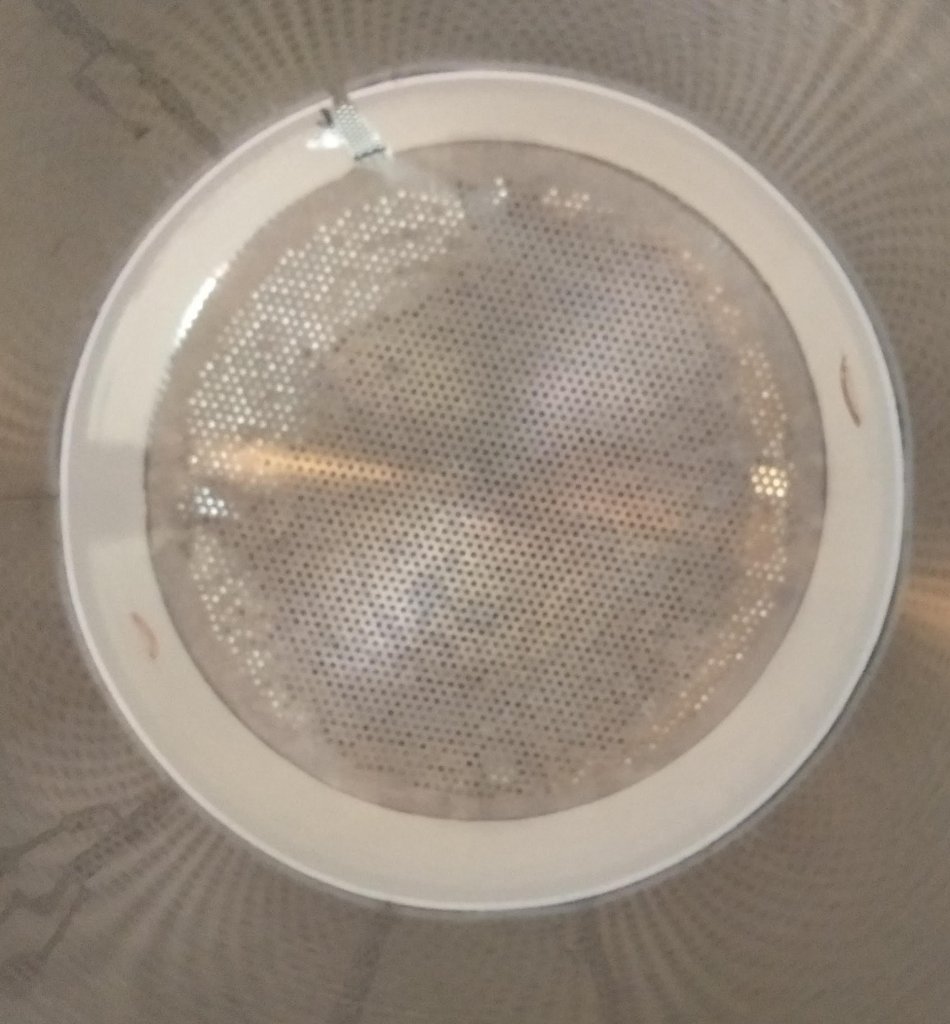You are using an out of date browser. It may not display this or other websites correctly.
You should upgrade or use an alternative browser.
You should upgrade or use an alternative browser.
Anvil Foundry Mash Eff
- Thread starter WeHeavy
- Start date

Help Support Homebrew Talk:
This site may earn a commission from merchant affiliate
links, including eBay, Amazon, and others.
No, they are not the same. Conversion efficiency measures how much of the starch in the grain was converted to sugar in the mash. Lauter efficiency is how much of the sugar that was created got into the BK. Mash efficiency is a combination of the two, and measures how much of the starch that was in the grain made it into the BK as sugar.I forgot to mention I have the 10.5 system.
I calculated the conversion efficiency (is that the same as mash efficiency?) and it was 62%.
Mash Efficiency = Conversion Efficiency * Lauter Efficiency.
It is possible to obtain 100% conversion efficiency, but lauter efficiency is always significantly less than 100%, due to wort retained in the spent grain mass. Lauter efficiency depends on whether you sparge or not, and the detailed sparge process if you do sparge. It also depends on the ratio of grain bill weight to pre-boil volume, with larger grain bills having lower efficiency, for a given sparge process and pre-boil volume.At a 62% mash efficiency it is almost certain that your conversion efficiency is much less than 100%.
Brew on

Having helped a friend with similar issues with his grainfather, I'm going to chime in and say that the size of your crush isn't really relevant here. you will get conversion if all your grain is hydrated after 60 minutes of mashing. The only thing the crush really affects is the rate of hydration due to the increased surface area of the grain particles. So if you want a faster mash, crushing fine will help, but if you are using all 60 minutes I don't think it's gaining you anything. So that leads to the assumption that your grain isn't getting hydrated evenly, which means you have channeling or no water in parts of your grain bed. This will hurt both conversion and lauter efficiency
A fine crush with shredded husks is more likely to cause channeling and incomplete grain hydration. Crush your grain slowly to preserve the husks and add 1 cup of rice hulls, stir your mash thoroughly, and slow your recirculation speed down as much as you can. When you sparge, do it as slowly as you can stand. Its all about water contact with the grain
A fine crush with shredded husks is more likely to cause channeling and incomplete grain hydration. Crush your grain slowly to preserve the husks and add 1 cup of rice hulls, stir your mash thoroughly, and slow your recirculation speed down as much as you can. When you sparge, do it as slowly as you can stand. Its all about water contact with the grain
- Joined
- Jan 17, 2017
- Messages
- 309
- Reaction score
- 139
OG was targeted at 1.065 and I ended at 1.059. So I am not too far off where I need to be.
I'm expecting my 10.5 to be delivered today so I'm no way an expert on this system but have done a lot of reading while waiting for it. First off your gravity is actually quite a bit off.
You received lots of good feedback but I'll pile on.
- Crush - some double crush, some use smaller gap, and some pre-condition the grain.
- Mash - some let the grain sit for 10-12 minutes to hydrate before starting to recirculate.
- Recirculate - as mentioned earlier slow it down.
- Mash out - mash out at 168F for around 10 minutes.
- Sparge - I've read a few use a "pseudo" sparge by pulling the pipe and rinsing the grains with hot wort at mash-out temperature for 10 minutes then drain grains for another 20 minutes.
Good Luck!
piperbrew
Well-Known Member
For those that have lined their mash pipe with a bag, what size bag have you found works well with the 10.5 Foundry? I've seen some say they ordered a custom wilser bag, but others seem to be using standard bags.

$719.00
$799.00
EdgeStar KC2000TWIN Full Size Dual Tap Kegerator & Draft Beer Dispenser - Black
Amazon.com

$22.00 ($623.23 / Ounce)
AMZLMPKNTW Ball Lock Sample Faucet 30cm Reinforced Silicone Hose Secondary Fermentation Homebrew Kegging joyful
无为中南商贸有限公司

$58.16
HUIZHUGS Brewing Equipment Keg Ball Lock Faucet 30cm Reinforced Silicone Hose Secondary Fermentation Homebrew Kegging Brewing Equipment
xiangshuizhenzhanglingfengshop

$53.24
1pc Hose Barb/MFL 1.5" Tri Clamp to Ball Lock Post Liquid Gas Homebrew Kegging Fermentation Parts Brewer Hardware SUS304(Liquid Hose Barb)
yunchengshiyanhuqucuichendianzishangwuyouxiangongsi
![Craft A Brew - Safale S-04 Dry Yeast - Fermentis - English Ale Dry Yeast - For English and American Ales and Hard Apple Ciders - Ingredients for Home Brewing - Beer Making Supplies - [1 Pack]](https://m.media-amazon.com/images/I/41fVGNh6JfL._SL500_.jpg)
$6.95 ($17.38 / Ounce)
$7.47 ($18.68 / Ounce)
Craft A Brew - Safale S-04 Dry Yeast - Fermentis - English Ale Dry Yeast - For English and American Ales and Hard Apple Ciders - Ingredients for Home Brewing - Beer Making Supplies - [1 Pack]
Hobby Homebrew

$20.94
$29.99
The Brew Your Own Big Book of Clone Recipes: Featuring 300 Homebrew Recipes from Your Favorite Breweries
Amazon.com

$176.97
1pc Commercial Keg Manifold 2" Tri Clamp,Ball Lock Tapping Head,Pressure Gauge/Adjustable PRV for Kegging,Fermentation Control
hanhanbaihuoxiaoshoudian

$44.99
$49.95
Craft A Brew - Mead Making Kit – Reusable Make Your Own Mead Kit – Yields 1 Gallon of Mead
Craft a Brew

$7.79 ($7.79 / Count)
Craft A Brew - LalBrew Voss™ - Kveik Ale Yeast - For Craft Lagers - Ingredients for Home Brewing - Beer Making Supplies - (1 Pack)
Craft a Brew

$33.99 ($17.00 / Count)
$41.99 ($21.00 / Count)
2 Pack 1 Gallon Large Fermentation Jars with 3 Airlocks and 2 SCREW Lids(100% Airtight Heavy Duty Lid w Silicone) - Wide Mouth Glass Jars w Scale Mark - Pickle Jars for Sauerkraut, Sourdough Starter
Qianfenie Direct

$10.99 ($31.16 / Ounce)
Hornindal Kveik Yeast for Homebrewing - Mead, Cider, Wine, Beer - 10g Packet - Saccharomyces Cerevisiae - Sold by Shadowhive.com
Shadowhive

$53.24
1pc Hose Barb/MFL 1.5" Tri Clamp to Ball Lock Post Liquid Gas Homebrew Kegging Fermentation Parts Brewer Hardware SUS304(Liquid Hose Barb)
Guangshui Weilu You Trading Co., Ltd
texaviator23
Well-Known Member
I am 10 brews in on the Anvil 10.5 and depending on my grain bill I average 70-75% mash efficiency. The main causes I’ve found for lower efficiency is recirculating to fast, not watching the ph, and grain crush. The holes on the side actually help the flow a lot unless you’re pulling to hard with the pump and compacting. I also find that going above 13lbs of grain my efficiency drops down to 70 and 14-16lbs it drops to around 68%.
All in all it’s a great system especially on 240v.
All in all it’s a great system especially on 240v.
Noob_Brewer
Well-Known Member
Agreed on all three of these issues. I recirculate very slow just to keep mash temps stable in this system. Without recirc, the 10.5g is so tall, there will be greater temp stratification if not recirculating. I keep track of my Ph too targeting 5.35ish. Use lactic acid to accomplish this. As for grind, I go finer with a wilser bag to help with mash efficiency. I use a cereal killer mill at 0.028”. I tried 0.025 and I think this was too fine for recirc and lautering so I like 0.028”. My last brew I had an “oat cream IPA” with 17.75lbs of grain + an additional 12oz of rice hulls. 6.5lbs of this was oats (malted and flaked combined) and 2.25lb of white wheat. So it was a hot sticky grain bill for sure. Mash lauter efficiency was 75.8% with a sparge and hit my volumes too. So very happy with this outcome.I am 10 brews in on the Anvil 10.5 and depending on my grain bill I average 70-75% mash efficiency. The main causes I’ve found for lower efficiency is recirculating to fast, not watching the ph, and grain crush. The holes on the side actually help the flow a lot unless you’re pulling to hard with the pump and compacting. I also find that going above 13lbs of grain my efficiency drops down to 70 and 14-16lbs it drops to around 68%.
All in all it’s a great system especially on 240v.
Brewer_Dad
Well-Known Member
I just ordered the 10.5 version. My main driver is to shorten the brewing time and space usage. I usually brew 5 gallon all grain batches with a 3 step setup. Never used BIAB or no sparge. I've scaled some of my recipes in brewfather changing the equipment profile and it adds 30% to the grain bill, I assume to correct the sparge.
Will be saving this post for further reading. Lots of good advice. Cheers!
Will be saving this post for further reading. Lots of good advice. Cheers!
You'll love it. It's simple, easy to clean, and takes up very little space. Keep in mind, you can sparge with this too. Some people have dedicated HLT's for the sparge. I re-purposed my old cooler mash-tun and use that as my HLT.
Brewer_Dad
Well-Known Member
You'll love it. It's simple, easy to clean, and takes up very little space. Keep in mind, you can sparge with this too. Some people have dedicated HLT's for the sparge. I re-purposed my old cooler mash-tun and use that as my HLT.
Yeah, I'm thinking about selling everything but a keg for sparging. But then I'd have to keep a burner too. I think I'll do a couple of batches, and compare results between sparging and no sparging before I decide.
So looking at my numbers, 15 brews done on the 10.5. All but two were 5.5 gallons, two were 3.5. My average mash efficiency is 79.93%, but that includes an outlier where I must have had a bad reading and had 122.7% mash eff for one beer which is obviously impossible. Dropping that one to 72% gives me a 76.55% mash efficiency. Brewhouse a 69.35% rate.
My process for all but my last two beers have been with a bag in the Foundry, grain conditioned before milling, milled at 0.040. Mash only stirred at beginning and at 15 minutes and between mash steps if any. Recirculation started at 15 mins into mash. Malt pipe lifted and bag pushed to drain more wort. RO water, adjusted with salts and pH control.
But my last two brews, I have tried brewing without a bag. Everything else the same...and with that one change my mash efficiency average for the two beers has been 80.2% and BH efficiency 74.25%. So for some reason, I get better numbers without a bag. I noticed that with a bag, the grain is very compacted it after the mash, so maybe without the bag I am getting better drainage through the grain bed. So I am going to stick to not using a bag for now.
My process for all but my last two beers have been with a bag in the Foundry, grain conditioned before milling, milled at 0.040. Mash only stirred at beginning and at 15 minutes and between mash steps if any. Recirculation started at 15 mins into mash. Malt pipe lifted and bag pushed to drain more wort. RO water, adjusted with salts and pH control.
But my last two brews, I have tried brewing without a bag. Everything else the same...and with that one change my mash efficiency average for the two beers has been 80.2% and BH efficiency 74.25%. So for some reason, I get better numbers without a bag. I noticed that with a bag, the grain is very compacted it after the mash, so maybe without the bag I am getting better drainage through the grain bed. So I am going to stick to not using a bag for now.
Snuffy
He ain't scared.
- Joined
- Nov 5, 2019
- Messages
- 1,920
- Reaction score
- 3,071
https://www.anvilbrewing.com/product-p/anv-foundry-ba.htmWell I modified the mash pipe by blocking off the side holes and my mash efficiency jumped up to 78% from 66%. That's a big jump. I was expecting a OG of 1.048 and got 1.049.
I noticed right off the bat that it took much longer for the sparge water to run down thru the mash, verse how it ran right thru the sides before.
I cut up an old fermenter bucket to use to block off the side holes. Since it kept floating when the water got hot I had to use copper wire to hold it in place.
[
I really like the Anvil even though I've had to make a few tweaks to it and it has a few draw backs, it's nothing that can't be overcome. I now spend more time thinking about brewing instead of cleaning the garage floor of winters grime and dragging out a ton of equipment and then putting it all away when done. It's taken 2 hours off my brew day just from clean up, setup and tear down. Now I setup next to the kitchen sink, pull up a chair, watch TV and have a cold brew.
You might want to reconsider selling stuff off until you’ve used this thing a few times. The issue you’ll run into is when you want to do big beers, like barleywines, RIS or the like. Check the grain capacity of your system. I believe the 10.5 can hold 16lbs. So you are not brewing 5 gallons of any real big beers on that. They make an adapter ring so you can brew 2.5 or 3 gallons if you want to brew a big beer. Or you could supplement with extract - and that’s always a viable option.Yeah, I'm thinking about selling everything but a keg for sparging. But then I'd have to keep a burner too. I think I'll do a couple of batches, and compare results between sparging and no sparging before I decide.
I have the 6.5. It has an 8 lb capacity. Honestly, that is sitting now as I’ve gone back to using my cooler mash tun for anything but the lightest gravity beers like bitter. With an 8 lb capacity, its a struggle to brew 3 gallons of anything over 1.060.
Brewer_Dad
Well-Known Member
You might want to reconsider selling stuff off until you’ve used this thing a few times. The issue you’ll run into is when you want to do big beers, like barleywines, RIS or the like. Check the grain capacity of your system. I believe the 10.5 can hold 16lbs. So you are not brewing 5 gallons of any real big beers on that. They make an adapter ring so you can brew 2.5 or 3 gallons if you want to brew a big beer. Or you could supplement with extract - and that’s always a viable option.
I have the 6.5. It has an 8 lb capacity. Honestly, that is sitting now as I’ve gone back to using my cooler mash tun for anything but the lightest gravity beers like bitter. With an 8 lb capacity, its a struggle to brew 3 gallons of anything over 1.060.
That's nice to know. Thx for the advice. I'm not usually a fan of big beers, the occasional stout or porter, but I usually keep around APAs, IPAs, and some beers with lots of body for the winter. My wife only drinks amber and the sort. That was also a factor when I decided to get the anvil.
I'm in Chile and there aren't much choices. I had to import the anvil through a 3rd party, retailers only sale Brewzillas, and I actually saved a couple hundred bucks. I might travel to the US early next year son I'm bringing back some accessories.
That's nice to know. Thx for the advice. I'm not usually a fan of big beers, the occasional stout or porter, but I usually keep around APAs, IPAs, and some beers with lots of body for the winter. My wife only drinks amber and the sort. That was also a factor when I decided to get the anvil.
I'm in Chile and there aren't much choices. I had to import the anvil through a 3rd party, retailers only sale Brewzillas, and I actually saved a couple hundred bucks. I might travel to the US early next year son I'm bringing back some accessories.
We’re big fans of Imperial Stout. It’s my wife’s favorite beer when she drinks beer and I usually end up brewing it 3 times a year. Our club does big beer projects - we’re in the process now of having a bunch of guys brew a 1.085 old ale and then we’re all going to get together and fill a used bourbon barrel and age it for awhile in that. I like to brew barleywine for Christmas and over the winter. I have a 1.060 brown ale I want to do next. I guess I do bigger beers more than I thought I was doing them when I bought the 6.5.
For the beers I can do on it, it works great.
- Joined
- Jan 17, 2017
- Messages
- 309
- Reaction score
- 139
I had a 15 gal. Boilermaker that I ran on NG and used a cooler tun. After three brews on the AF I sold it all. I did no sparge on the first couple of beers then sparged the last two. I found a big spaghetti pot from the kitchen works well to hold the 1-2 gallons of sparge water.Yeah, I'm thinking about selling everything but a keg for sparging. But then I'd have to keep a burner too. I think I'll do a couple of batches, and compare results between sparging and no sparging before I decide.
NSMikeD
Well-Known Member
good thread. I am in the camp that thinks chasing mash efficiency causes me undue worries and that consistent numbers is more important for me as a home brewer. So long as I can predict the outcome, the difference in $$$ for the additional grain was pennies.
I will be doing my 3rd batch on my 6.5gal Foundry (2.5 gal batches) soon and I'm not looking for high numbers but rather consistent numbers, From the get go, I presumed I would have a learning curve to get there.
So that being said, I am sipping the simple pale ale from my first Anvil Foundry brewed on 9/12 and loving the awesome cascade/amarillo/citra hop combo I put together for this brew. So out of curiosity I saw BeerSmith 3 says my estimated mash efficiency was 76.2% and my actual was 67%. My estimated OG was 1.053 with actual 1.047 but in the end the beer finished with 5.8% ABV (slight higher than predicted as FG was lower that predicted).
Here's the deal though. This is one of the best beers I have brewed. I think the beer said "67%? pfffft, who cares "
I can't argue with it.
I will be doing my 3rd batch on my 6.5gal Foundry (2.5 gal batches) soon and I'm not looking for high numbers but rather consistent numbers, From the get go, I presumed I would have a learning curve to get there.
So that being said, I am sipping the simple pale ale from my first Anvil Foundry brewed on 9/12 and loving the awesome cascade/amarillo/citra hop combo I put together for this brew. So out of curiosity I saw BeerSmith 3 says my estimated mash efficiency was 76.2% and my actual was 67%. My estimated OG was 1.053 with actual 1.047 but in the end the beer finished with 5.8% ABV (slight higher than predicted as FG was lower that predicted).
Here's the deal though. This is one of the best beers I have brewed. I think the beer said "67%? pfffft, who cares "
I can't argue with it.
- Joined
- Jan 17, 2017
- Messages
- 309
- Reaction score
- 139
good thread. I am in the camp that thinks chasing mash efficiency causes me undue worries and that consistent numbers is more important for me as a home brewer. So long as I can predict the outcome, the difference in $$$ for the additional grain was pennies.
I will be doing my 3rd batch on my 6.5gal Foundry (2.5 gal batches) soon and I'm not looking for high numbers but rather consistent numbers, From the get go, I presumed I would have a learning curve to get there.
So that being said, I am sipping the simple pale ale from my first Anvil Foundry brewed on 9/12 and loving the awesome cascade/amarillo/citra hop combo I put together for this brew. So out of curiosity I saw BeerSmith 3 says my estimated mash efficiency was 76.2% and my actual was 67%. My estimated OG was 1.053 with actual 1.047 but in the end the beer finished with 5.8% ABV (slight higher than predicted as FG was lower that predicted).
Here's the deal though. This is one of the best beers I have brewed. I think the beer said "67%? pfffft, who cares "
I can't argue with it.
Also - even after 4 brews on my AF I seem to be chasing volumes a bit but I'm getting there. My final volumes have been on the high side. So been adjusting grain absorption, boil-off, and other misc. losses.
This isn't directly AF efficiency related but sorta is - I haven't tried this but what about using the AF to heat mash water, putting that into a big igloo cooler, doing "normal" mashing, using the AF to heat sparge water (may need an intermediary container for the first runnings, hmm), sparging, and then using the AF for everything afterwards. Basically - it doesn't do it all, but it helps, and eliminates the propane needs.
Skeptonomicon
Member
- Joined
- Jan 19, 2020
- Messages
- 18
- Reaction score
- 10
On large foundry, consistent 72% efficiency. I have brewed up to 5 gal, 12 lbs grain without problem, although I did sparge on that beer. Another thing I have moved to to simplify my brew day is manually recirculating by taking about 1.5gal wort from the drain spigot and pouring back into the top using a 3 qt pot. I do this every 10 minutes or so. This might seem like more trouble than the recirculating pump, but the cleanup is so much easer.
This isn't directly AF efficiency related but sorta is - I haven't tried this but what about using the AF to heat mash water, putting that into a big igloo cooler, doing "normal" mashing, using the AF to heat sparge water (may need an intermediary container for the first runnings, hmm), sparging, and then using the AF for everything afterwards. Basically - it doesn't do it all, but it helps, and eliminates the propane needs.
This is broadly similar to my planned setup once my AF 6.5 arrives...
1. Use the AF to heat the initial strike water. (QUITE excited to have this on a timer!)
2. Do MIAB with a cooler.
3. During the hour-ish the mash is commencing, heat the remaining sparge water in the AF.
4. <have pot to hold sparge water at the ready> Transfer sparge water to this pot.
5. Pull first runnings from the cooler MT into the foundry and start it warming up.
6. Then sparge, pull 2nd runnings.
Commence the boil in earnest.
The only drawback with this setup is the need for a holding pot to transfer the sparge water into, which really isn't that big of a deal as the volume isn't large, at least on a 6.5 anyway.
This was designed for bigger beers, to allow maximum wort volume to fill the AF with the fewest extraneous parts. I already had the cooler, the bag, and the extra holding pot. I didn't opt for the AF pump kit (yet).
Alot of my small batch brews started on a stovetop, I never went the propane route. The MIAB step allowed me to step up from extract to AG with minimal overhead, tho the batch sizes were smaller due to stove limitations. For me a 6.5 AF is upsizing.
I ferment in corny kegs, so my MAX batch size into the fermenter is 4.5gal rather than the more common 5.5gal, which for stovetop volumes is pretty hefty.
Apologies for going OT here...
Willglenn
Member
- Joined
- Nov 13, 2019
- Messages
- 16
- Reaction score
- 15
After 6 beers with abysmal mash efficiency I've decided to break out my old mash tun. I've tried all of the easy stuff and am not interested in milling my grist to dust requiring a bag to keep the mud and hulls out of the brew kettle. My current crush is leaving far to much grain in the boil. I am still happy, the Foundry is a great boil kettle and HLT and I still get to brew inside, I'll just set the malt pipe off to the side and use my tried and true mash tun , which is way easier to clean.
Foundry should be good for heating mash water, but a few ideas for anyone doing a cooler for mashing instead:
Heavy Duty Timer: https://www.amazon.com/gp/product/B004TGO6RY/ref=ppx_yo_dt_b_search_asin_title?ie=UTF8&psc=1
Plugged into it is a temp controller: https://www.amazon.com/gp/product/B01KMA6EAM/ref=ppx_yo_dt_b_search_asin_title?ie=UTF8&psc=1
Controlling an immersion heater: https://www.amazon.com/gp/product/B08GXBC6FN/ref=ppx_yo_dt_b_asin_title_o00_s00?ie=UTF8&psc=1
This is my cooler mash tun setup. I get it all put together at night and by the time I walk into the garage in the morning my first step is to mash in. Then back into the house for coffee and breakfast, and then when I head out again I start sparge and so on.
I wonder what it is w/ the Foundry that gives lower efficiency? Simply the lack of or much smaller sparge?
Heavy Duty Timer: https://www.amazon.com/gp/product/B004TGO6RY/ref=ppx_yo_dt_b_search_asin_title?ie=UTF8&psc=1
Plugged into it is a temp controller: https://www.amazon.com/gp/product/B01KMA6EAM/ref=ppx_yo_dt_b_search_asin_title?ie=UTF8&psc=1
Controlling an immersion heater: https://www.amazon.com/gp/product/B08GXBC6FN/ref=ppx_yo_dt_b_asin_title_o00_s00?ie=UTF8&psc=1
This is my cooler mash tun setup. I get it all put together at night and by the time I walk into the garage in the morning my first step is to mash in. Then back into the house for coffee and breakfast, and then when I head out again I start sparge and so on.
I wonder what it is w/ the Foundry that gives lower efficiency? Simply the lack of or much smaller sparge?
I find the wide range of efficiencies intriguing, but understandable.
The AF is double-walled, but not as efficient holding heat as a cooler.
The mix of BIAB w' mesh bag, BIAB w' included malt pipe, or a combination of both adds all kinds of variables.
Some have opted for the circulation pump kit, while others have not.
Like many above, I could really care less about maximizing efficiency (just for the sake of it anyways). I'd much rather dial in the consistency, even if it is lower.
The AF is double-walled, but not as efficient holding heat as a cooler.
The mix of BIAB w' mesh bag, BIAB w' included malt pipe, or a combination of both adds all kinds of variables.
Some have opted for the circulation pump kit, while others have not.
Like many above, I could really care less about maximizing efficiency (just for the sake of it anyways). I'd much rather dial in the consistency, even if it is lower.
Mike_J_F
New Member
- Joined
- Feb 18, 2019
- Messages
- 1
- Reaction score
- 0
This has been a great thread to help my learn more about the Anvil 10.5 that I just started brewing with. Thank you to all the folks that have weighed in! Since I regularly harvest and re-use yeast, I'm intrigued about trying to use a bag with it to help reduce trub. Is there a particular bag and size that have worked well for folks?
Like many above, I could really care less about maximizing efficiency (just for the sake of it anyways). I'd much rather dial in the consistency, even if it is lower.
100% on the consistency thing...part of the reason why I finally broke down and bought my own damn mill. Final variable outside of my control.
Willglenn
Member
- Joined
- Nov 13, 2019
- Messages
- 16
- Reaction score
- 15
I think the low efficiency is due to the tall narrow kettle design, my old boil kettle was a 13 gallon stainless pot short and wide I boiled off 1.75 gallons in one hour, my AF boils off .5 gallons in an hour running on 120v ( I wish I could do 220 just not an option in my current setup). More water to get get more of the sugars out of the mash. As for the varied efficiencies I think those of you running 220v are doing better than those of us running on 120v and agreed the crush is critical, you can't get a consistent crush from the local brew shop.
Yesterday I brewed using my old mash tun using the Anvil recirc pump to transfer I also went to a 90 minute boil, my efficiency improved but not as much as I would like, the best part was I had beautiful clear grain free wort going into the AF for the boil. Now I'm not trying to get 80% efficiency in fact I see people claiming to get 90% I question their methods, I would just like to get to around 70% right now I'm in the low to mid 60's.
Yesterday I brewed using my old mash tun using the Anvil recirc pump to transfer I also went to a 90 minute boil, my efficiency improved but not as much as I would like, the best part was I had beautiful clear grain free wort going into the AF for the boil. Now I'm not trying to get 80% efficiency in fact I see people claiming to get 90% I question their methods, I would just like to get to around 70% right now I'm in the low to mid 60's.
Willglenn
Member
- Joined
- Nov 13, 2019
- Messages
- 16
- Reaction score
- 15
All of my AF beers have finished low, around 1.004 which leads me to believe the temperature control is not very accurate. I brewed yesterday using the AF as an HLT to heat strike water and then mash in my old cooler mash tun, the AF temp ran 3 degrees cooler than what my digital thermometer read. I had checked my thermometer and it's accurate at boil temp and freezing temp, but it could still be off in the middle temps. I then boiled in the AF.good thread. I am in the camp that thinks chasing mash efficiency causes me undue worries and that consistent numbers is more important for me as a home brewer. So long as I can predict the outcome, the difference in $$$ for the additional grain was pennies.
I will be doing my 3rd batch on my 6.5gal Foundry (2.5 gal batches) soon and I'm not looking for high numbers but rather consistent numbers, From the get go, I presumed I would have a learning curve to get there.
So that being said, I am sipping the simple pale ale from my first Anvil Foundry brewed on 9/12 and loving the awesome cascade/amarillo/citra hop combo I put together for this brew. So out of curiosity I saw BeerSmith 3 says my estimated mash efficiency was 76.2% and my actual was 67%. My estimated OG was 1.053 with actual 1.047 but in the end the beer finished with 5.8% ABV (slight higher than predicted as FG was lower that predicted).
Here's the deal though. This is one of the best beers I have brewed. I think the beer said "67%? pfffft, who cares "
I can't argue with it.
Similar threads
- Replies
- 4
- Views
- 1K
- Replies
- 3
- Views
- 611















































